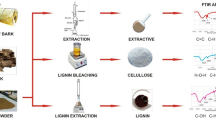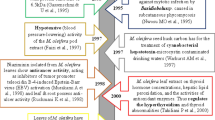The Use of Leaves from Young Trees of Quillaja saponaria (Molina) Plantations as a New Source of Saponins. Quillaja saponaria is an endemic tree in Chile. It has been extensively exploited for the extraction of saponins, which are used in mining, agriculture, and in the pharmaceutical and food industries. The overexploitation of native adult Quillaja forests has necessitated the establishment of plantations. Until now, biomass had been obtained from wood and bark of native adult trees, excluding the use of leaves due to their low biomass contribution to the whole tree, and also because industrial production lines have been designed for wood and bark and not for leaves that contain different compounds (e.g., chlorophyll). In this study, we propose using complete trees from young plantations, including the leaves. Quantification of saponins in the leaves of 24 three–year–old Quillaja trees from a plantation was carried out during the four seasons of one year. Our results showed that leaves represent 27.8% of the weight of the whole young trees and that leaves contain on average 2.58% of saponins. Considering that this amount is similar to that found in wood, we argue that leaves could contribute up to one–third of the saponins of young trees, making its processing key to attain good yields. Significant differences were observed in saponin contents during the four seasons. On average, the lowest concentration was found during winter (July = 1.39% dry weight) and the highest in autumn (April = 4.49%), suggesting that abiotic factors may have an affect on saponin production. A comparison among the 24 trees showed significant differences in saponin concentration (0.90% to 4.71%), supporting the need to select consistently superior saponin–producing trees. These results contribute to the understanding of a more sustainable production of Quillaja extracts, showing a potential to use whole young trees from plantations rather than only the wood and bark from native Quillaja forests.
Hojas de árboles jóvenes de Quillaja saponaria (Molina) de plantaciones, como nueva fuente de saponinas. El árbol Quillaja saponaria, endémico de Chile, ha sido ampliamente explotado para la extracción de saponinas, las cuales son utilizadas en la minería, la agricultura y diversas industrias como la farmacéutica y la de alimentación. La sobreexplotación de los bosques nativos ha planteado la necesidad de establecer plantaciones. Hasta la fecha, la biomasa se ha obtenido de la madera y corteza de árboles adultos nativos, excluyendo el uso de las hojas debido a su baja contribución (respecto del árbol total) y también porque las líneas de producción industrial han sido diseñadas específicamente para madera y corteza, no para las hojas que contienen diferentes compuestos, como la clorofila. En este estudio, se propone el uso de árboles completos de plantaciones jóvenes, incluyendo las hojas. Se realizaron cuantificaciones de saponinas en hojas de 24 árboles de una plantación de tres años de edad durante las cuatro estaciones de un año. Nuestros resultados mostraron que las hojas representan el 27,8% del peso total de árboles jóvenes y que contienen en promedio 2,58% de saponinas. Teniendo en cuenta que esa cantidad de saponinas es similar a la encontrada en madera, las hojas podrían contribuir hasta en un tercio de las saponinas de los árboles jóvenes, siendo clave el procesamiento de estas para alcanzar buenos rendimientos. Se observaron diferencias significativas en el contenido de saponinas durante las cuatro estaciones. En promedio, la concentración más baja se encontró durante el invierno (julio = 1,39% respecto a materia prima seca) y la mayor en otoño (abril = 4,49% respecto a materia prima seca), lo que sugiere que los factores abióticos podrían tener un efecto sobre la producción de saponinas. Además, se observaron diferencias significativas en cuanto a las concentraciones de saponinas entre los 24 árboles (0,90 a 4,71%), lo que plantea la necesidad de seleccionar árboles superiores en producción de saponinas. Estos resultados contribuyen a la comprensión de una forma de producción más sostenible de extractos de Quillaja, al mostrar el potencial de utilizar plantaciones de árboles jóvenes, incluyendo sus hojas, en lugar de sólo la madera y corteza ambos provenientes de bosques nativos.





Similar content being viewed by others
Literature Cited
Azmir, J., I. S. M. Zaidul, M. M. Rahman, K. M. Sharif, A. Mohamed, F. Sahena, M. H. A. Jahurul, K. Ghafoor, N. A. N. Norulaini, and A. K. M. Omar. 2013. Techniques for extraction of bioactive compounds from plant materials: A review. Journal of Food Engineering 117:426–436.
Barhate, G., M. Gautam, S. Gairola, S. Jadhav, and V. Pokharkar. 2013. Quillaja saponaria extract as mucosal adjuvant with chitosan functionalized gold nanoparticles for mucosal vaccine delivery: Stability and immunoefficiency studies. International Journal of Pharmacology 441:636–42.
Cares, M. G., Y. Vargas, L. Gaete, J. Sainz, and J. Alarcón. 2010. Ultrasonically assisted extraction of bioactive principles from Quillaja saponaria Molina. Physics Procedia 3:169–178.
Chapagain, B. P., A. Wiesman, and L. Tsror. 2007. In vitro study of the antifungal activity of saponin–rich extracts against prevalent phytopathogenic fungi. Industrial Crops and Products 26:109–115.
Cheok, C. Y., H. A. K. Salman, and R. Sulaiman. 2014. Extraction and quantification of saponins: A review. Food Research International 59:16–40.
Copaja, S. V., C. Blackburn, and R. Carmona. 2003. Variation of saponin contents in Quillaja saponica Molina. Wood Science and Technology 37:103–108.
Correa, C. and A. Martínez. 2013. Información tecnológica de productos forestales no madereros del bosque nativo en Chile. Antecedentes silvícolas y tecnológicos de Quillaja saponaria Mol. Proyecto CONAF–INFOR.
De Costa, F., A. C. A. Yendo, J. D. Fleck, G. Gosmann, and A. G. Fett–Neto. 2013. Accumulation of a bioactive triterpene saponin fraction of Quillaja brasiliensis leaves is associated with abiotic and biotic stresses. Plant Physiology and Biochemistry 66:56–62.
R Development Core Team 2014. R: A language and environment for statistical computing. Vienna, Austria.
Dirección Meteorológica De Chile. 2014. Productos climatológicos actuales e históricos. http://164.77.222.61/climatologia/ (2 September 2014).
Donoso, S., K. Peña, C. Pacheco, G. Luna, and A. Aguirre. 2011. Respuesta fisiológica y de crecimiento en plantas de Quillaja saponaria y Cryptocarya alba sometidas a restricción hídrica. Bosque 32:187–195.
Fischer, M. J. C., F. Pensec, G. Demangeat, S. Farine, J. Chong, M. Ramírez–Suero, G. Mazet, and C. Bertsch. 2011. Impact of Quillaja saponaria saponins on grapevine ecosystem organisms. Antonie van Leeuwenhoek 100:197–206.
Fleck, J. D., J. Schwambach, M. E. Almeida, A. C. A. Yendo, F. De Costa, G. Gosmann, and A. Fett–Neto. 2009. Immunoadjuvant saponin production in seedlings and micropropagated plants of Quillaja brasiliensis. In Vitro Cellular & Developmental Biology – Plant 45:715–720.
———, F. De Costa, A. C. A. Yendo, J. Segalin, T. C. T. Dalla Costa, A. G. Fett–Neto, and G. Gosmann. 2013. Determination of new immunoadjuvant saponin named QB–90, and analysis of its organ–specific distribution in Quillaja brasiliensis by HPLC. Natural Product Research 27:907–910.
Gaete–Garretón, L., Y. Vargas–Hernández, M. G. Cares–Pacheco, J. Sainz, and J. Alarcón. 2011. Ultrasonically enhanced extraction of bioactive principles from Quillaja saponaria Molina. Ultrasonics 51:581–585.
Grandón, A., M. Espinosa, D. Ríos, M. Sánchez, K. Sáez, V. Hernández, and J. Becerra. 2013. Variation of saponin contents and physiological status in Quillaja saponaria under different environmental conditions. Natural Product Communications 8:1697–1700.
Harrer, T., A. Plettenberg, K. Arastéh, J. Van Lunzen, G. Fätkenheuer, H. Jaeger, M. Janssens, W. Burny, A. Collard, F. Roman, A. Loeliger, M. Koutsoukos, P. Bourguignon, L. Lavreys, and G. Voss. 2014. Safety and immunogenicity of an adjuvanted protein therapeutic HIV–1 vaccine in subjects with HIV–1 infection: A randomised placebo–controlled study. Vaccine 32:2657–2665.
Honeyman, P. 2013. Mejoramiento genético forestal de especies nativas: La experiencia con quillay (Quillaja saponaria). Mundo Forestal 23:17–21.
Kamstrup, S., R. San Martin, A. Doberti, H. Grande, and K. Dalsgaard. 2000. Preparation and characterisation of Quillaja saponin with less heterogeneity than Quil–A. Vaccine 18:2244–2249.
Kensil, C. R. and R. Kammer. 1998. QS–21: A water–soluble triterpene glycoside adjuvant. Expert Opinion on Investigational Drugs 7:1475–1482.
———, ———, U. Patel, M. Lennick, and D. Marciani. 1991. Separation and characterization of saponins with adjuvant activity from Quillaja saponaria Molina cortex. Journal of Immunology 146:431–437.
Nord, L. I. and L. Kenne. 1999. Separation and structural analysis of saponins in a bark extract from Quillaja saponaria Molina. Carbohydrate Research 320:70–81.
Pulido, A. 2000. Funciones de Biomasa para Individuos de Regeneración Vegetativa de la Especie Quillaja saponaria Mol. Tesis Ingeniería Forestal. Pontificia Universidad Católica de Chile. Facultad de Agronomía e Ingeniería Forestal. Santiago, Chile.
Quiroz, I., E. García, M. González, P. Chung, and H. Soto. 2009. Vivero forestal: Producción de plantas nativas a raíz cubierta. Gobierno de Chile, Infor, Centro Tecnológico de la planta forestal, 128.
San Martín, R. 2000. Sustainable production of Quillaja saponaria Mol. saponins. In: Saponins in Food, Feedstuffs and Medicinal Plants, Proceedings of the Phythochemical Society of Europe, eds., W. Oleszek and A. Marston, 45, 271–279.
——— and R. Briones. 1999. Industrial uses and sustainable supply of Quillaja saponaria (Rosaceae) saponins. Economic Botany 53:302–311.
——— and ———. 2000. Quality control of commercial quillaja (Quillaja saponaria Molina) extracts by reverse phase HPLC. Journal of the Science of Food and Agriculture 80:2063–2068.
———, A. F. Otero, and A. Cruz. 2005a. Use of Quillaja saponins (Quillaja saponaria Molina) to control acid mist in copper electrowinning processes. Part 2: Pilot plant and industrial scale evaluation. Hydrometallurgy 77:171–181.
———, ———, M. Figueroa, V. Escobar, and A. Cruz. 2005b. Use of Quillaja saponins (Quillaja saponaria Molina) to control acid mist in copper electrowinning processes. Part 1. Laboratory scale evaluation. Hydrometallurgy 77:163–170.
Sfeir, J. L. 1990. Evaluación de la fitomasa y metabolitos de interés comercial en boldo (Peumus boldus Mol), quillay (Quillaja saponaria Mol) y eucaliptos (Eucalyptus spp.) en la VII región. Tesis para optar al título de Ingeniero Forestal. Santiago. Universidad de Chile. 83 p.
Sun, H. X., Y. Xie, and Y. P. Ye. 2009. Advances in saponin–based adjuvants. Vaccine 27:1787–1796.
Szakiel, A., C. Pączkowski, and M. Henry. 2011. Influence of environmental abiotic factors on the content of saponins in plants. Phytochemistry Reviews 10:471–491.
Yang, Y., M. E. Leser, A. A. Sher, and D. J. Mcclements. 2013. Formation and stability of emulsions using a natural small molecule surfactant: Quillaja saponin (Q–Naturale®). Food Hydrocolloids 30:589–596.
Zagal, E. and R. Sadzawka. 2007. Protocolo de métodos de análisis para suelos y lodos. Universidad de Concepción, Facultad de Agronomía, Chillán. Comisión de Normalización y Acreditación de la Sociedad Chilena de la Ciencia del Suelo.
Zúñiga, G. E., M. P. Junqueira–Gonçalves, M. Pizarro, R. Contreras, A. Tapia, and S. Silva. 2012. Effect of ionizing energy on extracts of Quillaja saponaria to be used as an antimicrobial agent on irradiated edible coating for fresh strawberries. Radiation Physics and Chemistry 81:64–69.
Acknowledgments
The authors would like to thank Mr. Hugo Vera and Mr. Patricio Guzmán from Las Palmas Quillaja farm for their constant support and collaboration during the sampling of the trees and their innovation in starting the first industrial Quillaja domestication. Also, the authors are grateful to Dr. Leandro Padilla of Natural Response S.A. for facilitating the saponin standard, UHPLC analysis, and his kind comments and revision of the manuscript. This research was supported by two grants: FIA PYT–2013–0028 from the Ministry of Agriculture and PAI 781301001 from the Ministry of Education, both from the Chilean Government.
Author information
Authors and Affiliations
Corresponding author
Additional information
Submitted 23 February 2015; Accepted 22 August 2015.
Rights and permissions
About this article
Cite this article
Schlotterbeck, T., Castillo–Ruiz, M., Cañon–Jones, H. et al. The Use of Leaves from Young Trees of Quillaja saponaria (Molina) Plantations as a New Source of Saponins. Econ Bot 69, 262–272 (2015). https://doi.org/10.1007/s12231-015-9320-0
Received:
Accepted:
Published:
Issue Date:
DOI: https://doi.org/10.1007/s12231-015-9320-0




